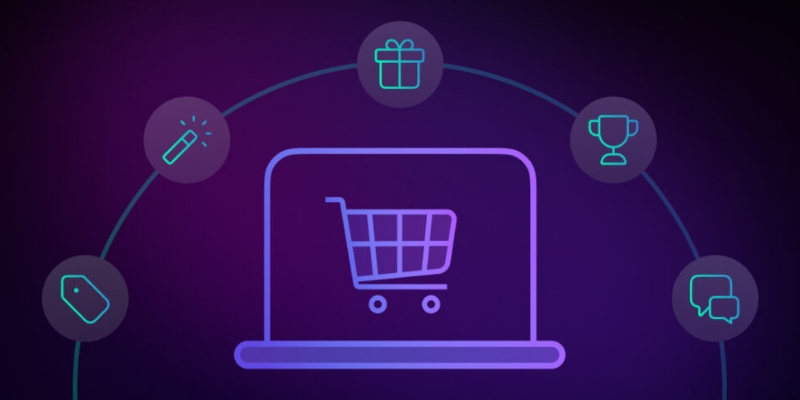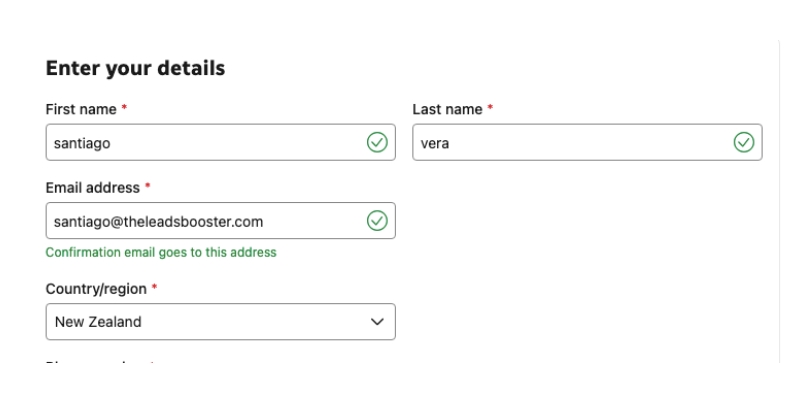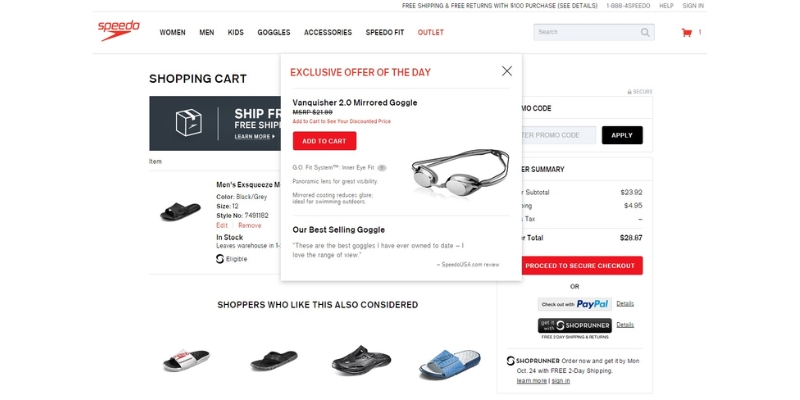Lucia Lee
Last update: 17/10/2025
Many ecommerce businesses focus on creating the best product page in the world, yet forget that the real magic happens at the checkout page. When done wrong, the checkout process can drive could-have-been customers away. Thankfully, you can use AI for checkout optimization, preventing shoppers from filling their carts only to vanish right before completing the purchase. By learning from shopper behavior and removing unnecessary friction, AI helps create a seamless, personalized checkout flow that traditional methods cannot. Keep reading to discover how you can use AI to turn more carts into completed sales.
Checkout optimization is the process of refining and improving the checkout flow of an online store to make it faster, simpler, and more intuitive for shoppers. It focuses on reducing friction and ensuring that customers can complete their purchases effortlessly - ultimately boosting sales conversion and improving the overall customer experience.
Even the best product pages can’t make up for a poor checkout experience. As every second of friction can cost you conversions and loyal customers, checkout optimization is no longer a nice-to-have; it’s a must-have for ecommerce businesses. Here are the top reasons why checkout optimization should be your top priority:

Why checkout optimization matters
AI for checkout optimization isn’t powered by a single tool - it’s an ecosystem of advanced technologies working together to make the purchase journey faster, smoother, and more intuitive. Here is a breakdown of the key technologies behind AI-driven checkout optimization:
Machine learning (ML)
Machine learning is a subset of AI that enables systems to learn from data and improve over time without being explicitly programmed. In checkout optimization, ML helps ecommerce platforms personalize checkout flows. It can also detect fraud in real time by recognizing unusual transaction patterns.
Natural language processing (NLP)
Natural language processing allows computers to understand and respond to human language. This AI for checkout optimization technology powers chatbots that can answer last-minute customer queries about delivery, payment, or returns, reducing hesitation and helping shoppers complete their purchases faster.
Predictive analytics
Predictive analytics uses statistical models and historical data to forecast future outcomes. By anticipating what customers are likely to do next, it helps ecommerce brands make proactive decisions that enhance checkout performance. In checkout optimization, predictive models can identify when a customer is at risk of abandoning their cart and trigger timely interventions, such as discount pop-ups or one-click checkout reminders. It also helps businesses forecast demand and optimize inventory to ensure a smoother buying process.
In the competitive world of ecommerce, the smallest delay or inconvenience in the checkout process can push potential customers towards competitors that use AI for checkout optimization. Let’s explore how AI reshapes every aspect of the checkout journey.
Automated form filling
Manual data entry is one of the biggest barriers to completing a purchase. With checkout process automation in eCommerce, AI simplifies this step through smart autofill and error detection. It can instantly complete address and payment fields using saved data, correct mistakes in real time, and even adapt form length based on whether the customer is new or returning.
This not only reduces friction but also enhances personalization, making the process feel seamless and relevant for each shopper. For example, repeat buyers can skip redundant fields, while new shoppers get gentle prompts for the essentials - all optimized automatically through behavior analysis.

Automated form filling
AI-driven fraud detection
Lightening-fast and frictionless transactions shouldn’t compromise transaction security. Through advanced fraud detection models, AI analyzes hundreds of data points per transaction - from IP location and device fingerprints to purchasing behavior and frequency patterns. This enables businesses to catch suspicious activity instantly while ensuring legitimate customers face zero unnecessary friction.
What makes this so powerful is its ability to learn over time. AI for checkout optimization continuously adapts its risk models, offering stronger protection with each interaction. This balance between fraud prevention and smooth checkout keeps both merchants and customers protected, reinforcing trust and boosting long-term loyalty.
Seamless and smart payment integration
AI simplifies payment processing by connecting with multiple merchant services and dynamically displaying the most relevant options for each user. With AI-powered payment recommendation systems, customers automatically see preferred methods - whether digital wallets, local bank transfers, or credit cards - based on location, past purchases, and device type.
This personalization in payment flow not only enhances the customer experience but also improves sales conversion. When checkout journeys feel tailored rather than generic, it’s not just customers who receive benefits - your business also benefits from fewer abandoned carts and faster payment processing.
Personalized cross-sells and upsells
Ecommerce businesses often place cross-sells and upsells on the checkout page as a strategy to boost revenue. AI for checkout optimization takes it beyond guesswork through personalization driven by deep data analytics. By studying browsing history, previous purchases, and even cart combinations, AI recommends products that align perfectly with each shopper’s needs.
For example, if a customer buys a camera, the system might suggest a lens kit or protective bag. These dynamic recommendations turn the checkout page into a subtle sales engine, boosting sales conversion without overwhelming the buyer. This level of personalized checkout flow using AI ensures every recommendation feels like a helpful addition - not a pushy sales tactic.

Personalized cross-sells and upsells
Also read: Personalized Product Recommendations: The Ultimate Guide
AI chatbot for instant customer support
Sometimes customers just need a quick answer before committing. AI-powered chatbots integrated into the checkout page provide instant, round-the-clock assistance - whether it’s clarifying shipping details, explaining payment options, or addressing last-minute doubts.
These virtual assistants leverage natural language processing and real-time insights to respond contextually, often resolving issues faster than human agents. The result? A smoother customer experience, reduced cart abandonment, and increased trust in your e-commerce solutions.
Automated A/B testing and real-time optimization
AI doesn’t just enhance checkout once - it continuously makes it better. Through real-time checkout optimization using machine learning, businesses can automatically test and refine page layouts, button placements, and user interface designs based on live customer interactions.
Unlike traditional A/B testing, AI systems adjust on the fly, using behavior analysis to identify what truly drives conversions. This automation means your checkout process evolves in real time - adapting to seasonal changes, customer segments, and shifting shopping habits - without requiring constant manual updates.
Enhancing guest checkout experience
Many shoppers hesitate to create accounts for checkout, preferring speed and privacy. AI for checkout optimization bridges that gap by streamlining guest checkout while maintaining convenience and personalization. It can securely remember essential details for returning visitors, offering one-click checkout without mandatory sign-ins.
This approach appeals to first-time or privacy-conscious customers, improving sales conversion while collecting valuable data analytics for future personalization. In essence, it delivers a fast, familiar checkout experience without sacrificing security or trust.
AI-powered tools for reducing cart abandonment
AI tools excel at spotting when a customer is about to leave and intervening just in time. Using predictive behavior analysis, these systems detect inactivity, mouse movements, and exit intent to trigger targeted actions such as personalized discounts, reminders, or limited-time offers.
Some systems even integrate predictive analytics with email retargeting, ensuring no cart is left forgotten. This intelligent intervention, supported by real-time insights, is a powerful tool to recover abandoned carts, dramatically improving sales conversion and overall revenue.
Predictive analytics for cart abandonment prevention and other strategies
Finally, AI brings foresight to checkout management. By combining predictive analytics and data analytics, businesses can forecast when and why customers abandon carts, enabling proactive optimization.
Checkout insights also strengthen pricing strategy and inventory management, ensuring that stock availability, promotions, and discounts align with real shopper behavior. This helps businesses provide a more efficient, customer-focused checkout process that turns hesitation into confident purchases.

Predictive analytics for cart abandonment prevention and other strategies
While AI for checkout optimization brings tremendous potential to streamline checkout and boost conversions, it also introduces several challenges that ecommerce businesses must navigate carefully:
Data quality and availability
AI-driven checkout optimization depends on vast amounts of clean, accurate data - from transaction histories to user behavior patterns. When data is incomplete, inconsistent, or outdated, AI systems can misinterpret buyer intent, suggest irrelevant actions, or slow down checkout rather than improve it. Smaller businesses often struggle to gather enough high-quality data for AI to perform effectively.
Integration with existing ecommerce systems
Many ecommerce platforms still run on legacy systems that don’t easily integrate with advanced AI tools. Aligning AI with existing payment gateways, inventory management, and CRM systems can be complex and time-consuming, often requiring extensive technical support or even infrastructure upgrades.
Privacy and data security concerns
Checkout involves highly sensitive customer information, from payment details to addresses and personal identifiers. Using AI to process this data raises privacy and compliance concerns, especially under regulations like GDPR or CCPA. Any mishandling or breach could severely damage customer trust and brand reputation.
High implementation and maintenance costs
Building, deploying, and maintaining AI systems for checkout optimization isn’t cheap. From hiring data experts and engineers to maintaining servers and software, costs can quickly add up. Even ready-made AI checkout tools often come with subscription fees, integration expenses, and the need for staff training.
Technical complexity and talent shortage
AI systems require deep expertise in data science, machine learning, and ecommerce operations. Many companies lack in-house capabilities to manage or fine-tune AI models effectively, forcing them to depend on external experts. This not only increases costs but can also delay updates and optimization cycles.

Challenges in using AI for checkout optimization
Algorithm bias and inaccurate predictions
AI models learn from historical data, which means they can inherit biases or misinterpret behavioral patterns. For instance, an AI system might incorrectly flag legitimate transactions as fraud or over-prioritize certain payment methods, creating friction at checkout. Continuous monitoring and retraining are needed to prevent these issues.
Balancing automation and customer experience
While AI can simplify checkout steps, too much automation - such as aggressive upselling or overly predictive behavior - can backfire. If customers feel rushed or monitored, they may abandon their carts entirely. Maintaining a balance between personalization and control is crucial for a seamless experience.
Scalability and performance
As order volumes grow, AI systems must scale without compromising speed or accuracy. High-traffic periods like sales or holidays can overload poorly optimized AI systems, leading to delays or checkout errors - exactly the problems AI was meant to solve.
Measuring ROI and continuous improvement
Determining the true return on investment for AI checkout optimization can be tricky. Results often take time, and without proper tracking, businesses may not clearly see how AI impacts conversions or cart recovery. Ongoing evaluation and fine-tuning are essential to maximize value.
A seamless checkout isn’t just the end of the shopping journey - it’s the moment that decides whether curiosity turns into conversion. With AI for checkout optimization, ecommerce brands can remove friction, personalize the buying flow, and recover sales that would’ve otherwise been lost to cart abandonment.
At Sky Solution, we help ecommerce businesses harness AI to optimize not only every stage of the checkout process but also your whole online store - boosting sales conversion, improving customer experience, and driving sustainable revenue growth. Contact us now for a free consultation!